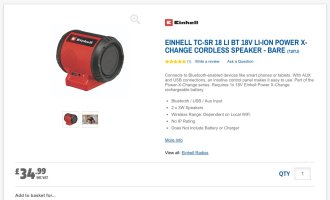You are using an out of date browser. It may not display this or other websites correctly.
You should upgrade or use an alternative browser.
You should upgrade or use an alternative browser.
Are USB-C Chargers Interchangeable?
- Thread starter Spymaster
- Start date
UnderOpenSky
baseline neural therapy
What kind of leads do young people’s kettles have on them?
They don't. It's hardwired to the base, which the kettle detaches from. Do you still have a kettle with an old skool lead?
Spymaster
Plastic Paddy
They don't. It's hardwired to the base, which the kettle detaches from. Do you still have a kettle with an old skool lead?
No. We have one that sits on a base too, but I had to go and check just now.
kalmatthew
Lurker Extrodinaire
Nerdy pedantry alert!
A handy image for reference (odd is socket, even plug)

These days it will be a switch mode power supply not a transformer, they get to the same place but in very different ways.The box is a transformer and AC->DC converter. It probably doesn't need to be quite the size it is for the measly 65W (most of them are that) it outputs, but it lets them standardise on having one cable+box and several dozen cables that attach to that for every plug standard in the world. Most phones draw little enough power that all of this tech sits in the plug itself. You'll notice the laptop's wall plug has enough space for the wires and prongs and that's it. The phone plug will be chunkier.
And they are of course wrong that is a C14 connector and only rated to 70°C an actual kettle lead is a C16 has a notch in the base and is rated to 120°C. And of course neither is to. Be confused with the C6 or clover leaf connector.Most people I have come across refer to kettle leads meaning IEC's.
Like this.
View attachment 447930
A handy image for reference (odd is socket, even plug)

Exactly!So yeah stop getting lead names wrong.
kabbes
First intersubjective, then internalised
You’re my new favourite.Nerdy pedantry alert!
These days it will be a switch mode power supply not a transformer, they get to the same place but in very different ways.
And they are of course wrong that is a C14 connector and only rated to 70°C an actual kettle lead is a C16 has a notch in the base and is rated to 120°C. And of course neither is to. Be confused with the C6 or clover leaf connector.
A handy image for reference (odd is socket, even plug)
View attachment 447972
Exactly!
kalmatthew
Lurker Extrodinaire
I gave up engineering as a profession soon after I left university, but every now and then my inner engineer finds an outlet....
ChrisD
.
I have several rechargeable einhell batteries (+drill/torch/strummer etc). I see that they sell a Bluetooth speaker that has a usb charge point. Wondering it this could effectively turn these chunky batteries into power banks for mobile phone etc ? Any other way to use these for phone charging on extended holiday trips etc as I don’t need another Bluetooth speaker?
Can one work out how many times a 3.0Ah 18V battery would charge my pixel 8 phone (4575mAh)?
Can one work out how many times a 3.0Ah 18V battery would charge my pixel 8 phone (4575mAh)?
Attachments
WouldBe
Dislicksick
None. It's 18v instead of the 5v available through USB.Can one work out how many times a 3.0Ah 18V battery would charge my pixel 8 phone (4575mAh)?
You'd need some sort of adapter to drop the voltage.
MrsArcanum
Happy Year of The Luminous Lemur 2025
Alternatively known as a PC power cable.It's a kettle lead!
Although it occurred to me the other day that the younger folks I work with have probably never seen a kettle with a lead like this.
UnderOpenSky
baseline neural therapy
ChrisD
.
The spec. Shows USB output 5v 2A.....so must be some integral transformer built in....None. It's 18v instead of the 5v available through USB.
You'd need some sort of adapter to drop the voltage.
WouldBe
Dislicksick
There would be in the case of the cordless speaker but not directly from the battery.The spec. Shows USB output 5v 2A.....so must be some integral transformer built in....
MrsArcanum
Happy Year of The Luminous Lemur 2025
That wouldn't fit my PC.
UnderOpenSky
baseline neural therapy
That wouldn't fit my PC.
Exactly. And yet it's a PC power cable.
Everyone knows what is meant by kettle lead. If you want to be precise, then pick the type on the diagram posted above. But PC power cable isn't very helpful.
gentlegreen
I hummus, therefore I am ...
.
Last edited:
gentlegreen
I hummus, therefore I am ...
3x18 = 54 watt hoursI have several rechargeable einhell batteries (+drill/torch/strummer etc). I see that they sell a Bluetooth speaker that has a usb charge point. Wondering it this could effectively turn these chunky batteries into power banks for mobile phone etc ? Any other way to use these for phone charging on extended holiday trips etc as I don’t need another Bluetooth speaker?
Can one work out how many times a 3.0Ah 18V battery would charge my pixel 8 phone (4575mAh)?
3.7 x 4.575 = 17 watt hours
so approx 3 times -assuming the declared capacities are accurate.
And it's unlikely to be a smart charger - so slow...
rubbershoes
not the only raver in the village
Threads like this reinforce how little I know about technical matters
MrsArcanum
Happy Year of The Luminous Lemur 2025
Son wouldn't & he has built and upgraded all the PCs in the house.Exactly. And yet it's a PC power cable.
Everyone knows what is meant by kettle lead. If you want to be precise, then pick the type on the diagram posted above. But PC power cable isn't very helpful.
UnderOpenSky
baseline neural therapy
Son wouldn't & he has built and upgraded all the PCs in the house.
Well, I hope you correct him when he calls them PC power cables and not IEC C13 connectors.

Why do those modern switch mode power supplies 'not transformers' cause such massive interference on AM and SW radio?Nerdy pedantry alert!
These days it will be a switch mode power supply not a transformer, they get to the same place but in very different ways.
And they are of course wrong that is a C14 connector and only rated to 70°C an actual kettle lead is a C16 has a notch in the base and is rated to 120°C. And of course neither is to. Be confused with the C6 or clover leaf connector.
A handy image for reference (odd is socket, even plug)
View attachment 447972
Exactly!
gentlegreen
I hummus, therefore I am ...
They use high frequency for efficiency and to use far smaller transformers / inductors / capacitors - with lots of harmonics.Why do those modern switch mode power supplies 'not transformers' cause such massive interference on AM and SW radio?
If you want to be alarmed :-
DiodeGoneWild
This is my channel about hobby electronics, teardowns, DIY, experiments, ...
Terrifying stuff.They use high frequency for efficiency and to use far smaller transformers / inductors / capacitors - with lots of harmonics.
If you want to be alarmed :-

DiodeGoneWild
This is my channel about hobby electronics, teardowns, DIY, experiments, ...www.youtube.com
I try not to think about how many we have left plugged in permanently for computers, phones, TVs, streaming sticks etc. The stairs are made of wood and the window openings are too small to get out of and then there's the drop...
Similar threads
- Replies
- 6
- Views
- 367
- Replies
- 26
- Views
- 966
- Replies
- 4
- Views
- 254



